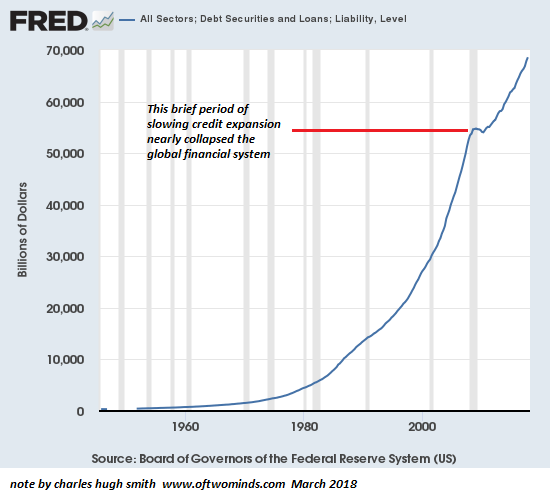Alas, fakery isn’t actually a solution to fiscal/financial crisis..
| This chart of “debt securities and loans”–i.e. total debt in the U.S. economy–is also a chart of the creation and distribution of new money, as the issuance of new debt is the mechanism in our financial system for creating (or “emitting” in economic jargon) new currency: when a bank issues a new home mortgage, for example, the loan amount is new currency created out of the magical air of fractional reserve banking. |
Debt Securities and Loans, 1960 - 2018 |
Central banks also create new currency at will, and emitting newly created money is how they’ve bought $21 trillion in assets such as bonds, mortgages and stocks since 2009. Is there an easier way to push asset valuations higher than creating “money” out of thin air and using it to buy assets, regardless of the price? If there is an easier way, I haven’t heard of it.
Which brings us to the question: how much longer can we get away with this travesty of a mockery of a sham? How much longer can we get away with creating “money” by issuing new debt/liabilities to grease the consumption of more goods and services and the purchases of epic bubble-valuation assets?
Since humans are still using Wetware 1.0 (a.k.a. human nature), we can constructively refer to the Roman Empire’s experience with creating “money” with no intrinsic value. The reason why the Roman Empire (Western and Eastern) attracts such attention is 1) we have a fair amount of documentation for the period, something we don’t have for other successful empires such as the Incas, and 2) we’re fascinated by the decline and collapse of the Western Empire, a structure so vast and successful that collapse seemed impossible just a few decades before the final unraveling.
One of the books I’m currently enjoying is The Fate of Rome: Climate, Disease, and the End of an Empire, a new exploration of the impact of climate change and pandemics on the Roman Empire’s final few centuries.
The key takeaway is that climate change undermined the production of grain while the arrival of previously unknown diseases via trade routes stretching from Rome to China, India and the interior of Africa decimated the productive populace. Add in the rise of well-organized “barbarians” and the political instability born of a self-serving, ossified elite and voila, you have an excellent recipe for crisis.
Crises tend to reduce tax collections and increase government/Imperial costs, and this creates a fiscal/financial crisis. The Romans didn’t have a fiat currency that a central bank could create out of thin air, so they did the next best thing which was to replace their mostly-silver coinage with new base-metal coinage that had been washed in silver. That is, they debased/devalued their money, replacing coinage with an intrinsic value of silver with coinage with little to no intrinsic value.
They got away with this debasement/ devaluation for quite a few years, and so naturally they reckoned they could get away with it forever. But alas, debauching the currency is not a permanent solution to insolvency; it is a one-time trick that fools the market and populace for a time but soon enough people catch on and bad money drives out good money (Gresham’s law) as people hoarded the old silver coins and tried to trade the worthless new coins for anything but more worthless “money.”
In the present, we see this process at work in Venezuela, where the government has debauched the nation’s currency, the bolivar, to the point that inflation (i.e. loss of purchasing power) is running around 7,000% annually.
So how long can we get away with creating “money” out of thin air and using it to pump up asset prices? The Roman leaders who in desperation debased the Empire’s currency/coinage must have been chortling at the fast one they pulled on the Empire’s merchants, markets, farmers and soldiers, and we must forgive their avid willingness to believe that they could get away with it essentially forever.
Alas, fakery isn’t actually a solution to fiscal/financial crisis. At this moment in time, our “leadership” is basking in the hubris-soaked confidence that we can get away with it if not forever then for decades to come: we can borrow currency into existence in as many trillions as we desire, and inflation will remain dormant, consumption will remain robust and everyone will accept the debauched currency as having value.
| Until they don’t. This is typically a sudden and unexpected event, as this chart of the exchange rate of the bolivar to the US dollar shows: the slide from 10 bolivars to the USD to 25 bolivars to one USD was gradual, but the implosion to 200,000 bolivars to the USD was frighteningly rapid. |
Bolivar/US Dollar, 2010 - 2018 - Click to enlarge |
Tags: newslettersent






































